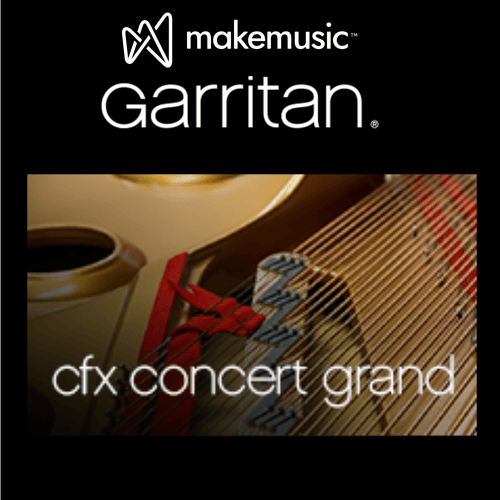
Instant-Download vs. Cloud-Based Software: Pros and Cons
Remember when “installing software” meant unwrapping a shiny CD, popping it into the drive, and hoping it didn’t scratch halfway through setup? Yeah. That era’s gone. Now, you can download...

The Garritan Abbey Road Studios CFX Concert Grand places the user on the bench before the Yamaha CFX, an incredible concert grand piano characterized by a wide palette of tonal colors and the ability to create the most subtle, expressive nuances. This beautiful instrument is matched with the stunning acoustics of Abbey Road Studios’ legendary Studio One and the finest collection of microphones in the world.
All facets of this project – the instrument, the room, the mics, and the recording expertise – work together to create the finest sampled piano ever captured. Experience the passion reflected in every detail.
Abbey Road Studios is the most famous recording studios in the world and a global music icon. Home to countless landmark recordings and pioneering advances in recording technology, the legendary studio complex has a phenomenal history spanning over 80 years, encompassing celebrated work by many of the world’s most famous recording artists including The Beatles, Pink Floyd, Kanye West, Elton John, Oasis, Elbow, Lady Gaga and Adele. Composers and musicians from around the world turn to Abbey Road Studios when they desire the very best.
Abbey Road Studios’ Studio One is one of the largest and most beautiful sounding orchestral studios in the world. The space can easily accommodate a 110 piece orchestra and 100 piece choir simultaneously. Studio One’s acoustics are as famous as its location, offering a supremely warm and clear sound with a reverb time of 2.3 seconds. This makes it perfect for numerous types of recording, from solo piano to large orchestras.
Studio One is Abbey Road’s largest recording space and has enjoyed a remarkable history. Architects Wallis Gilbert and Partners decorated the original walls of Studio One in their distinctive art-deco style, which gave the room a darker sound than its current, superior-sounding incarnation. In 1931 the impressive room hosted Abbey Road’s inaugural recording session with Sir Edward Elgar, and has since hosted historic sessions by the London Symphony Orchestra and luminaries ranging from Yehudi Menuhin, Pablo Casales, Bela Bartok and Jascha Heifetz to Glenn Miller and Fats Waller. In 1967, Studio One played host to The Beatles’ famous performance of ‘All You Need Is Love,’ which was captured as part of the first ever live, international satellite TV broadcast.
When Studio One opened, it was used primarily by EMI’s prestigious His Master’s Voice (HMV) label and it continues to host classical recordings to this day. It is also one of the world’s premiere locations for movie scoring: the long list of blockbuster scores recorded in Studio One includes Raiders of the Lost Ark, Star Wars, the Lord of The Rings Trilogy and Gravity.
To expand your creative possibilities, Abbey Road Studios’ engineers created three discrete microphone perspectives: Classic, Contemporary, and Player.
The Classic perspective most faithfully captures the natural tonal character, clarity and nuance of the instrument.
Close – 2 x Neumann M49 and 2 x Neumann KM184 Microphones: As every piano, recording venue, repertoire and pianist are different, the M49 and KM184 are used to capture a close detailed sound, which is especially good for chamber music.
Mid Field/Wide – 2 x DPA 4006 Microphones: The DPA 4006’s placed at each end of the piano create a wider and more spacious sound picture.
Main – 2 x Neumann TLM50 Microphones: The Neumann TLM50 are placed 2m away from the instrument and at 2.6m in height. This captures the overall complex frequency response and dynamic range of a grand piano.
The Contemporary perspective creates a piano sound that is bright and hard with lots of attack from the hammers, but also maintains the piano’s warmth with intimate ambience.
Close – AKG C12 & D19 Microphones: The AKG C12 is a bright sounding valve microphone with bite and some nice valve warmth.The mono D19 placed in the centre over the hammers was run via a classic REDD.47 valve microphone preamp, adding central focus and ‘poke’ to the close sound of this set up.
Ambience – Schoeps MK 2H Microphones: For the Ambience microphones Schoeps MK 2H are used in a close position. They are able to bring the sound of the room to the mix, without losing too much of the definition of the piano’s initial attack.
The Player perspective offers the experience of playing the CFX, from the piano bench, in Studio One, particularly when reproduced over high quality headphones.
Close – 2 x Neumann KM84 Microphones: This is a straight forward stereo pair placed closely and directly over the hammers. It provides an immediate sound of the piano with little coloration from the room.
Player – Neumann KU100 Dummy Head: The Binaural KU100 Dummy Head was placed directly behind the musicians head. This provides an intimacy to the instrument mixed with the unmistakable sense of playing the instrument in the acoustics of Studio One.
Garritan has worked closely with Abbey Road Studios to develop presets that are both functionally useful and inspiring to play. Research included artists and genres as well as notable recordings, cinematic settings and live performance examples to make the CFX as flexible and versatile a musical instrument as possible.
Price: $159.00
The Garritan Abbey Road Studios CFX Concert Grand places the user on the bench before the Yamaha CFX, an incredible concert grand piano characterized by a wide palette of tonal colors and the ability to create the most subtle, expressive nuances. This beautiful instrument is matched with the stunning acoustics of Abbey Road Studios’ legendary Studio One and the finest collection of microphones in the world.
All facets of this project – the instrument, the room, the mics, and the recording expertise – work together to create the finest sampled piano ever captured. Experience the passion reflected in every detail.
Abbey Road Studios is the most famous recording studios in the world and a global music icon. Home to countless landmark recordings and pioneering advances in recording technology, the legendary studio complex has a phenomenal history spanning over 80 years, encompassing celebrated work by many of the world’s most famous recording artists including The Beatles, Pink Floyd, Kanye West, Elton John, Oasis, Elbow, Lady Gaga and Adele. Composers and musicians from around the world turn to Abbey Road Studios when they desire the very best.
Abbey Road Studios’ Studio One is one of the largest and most beautiful sounding orchestral studios in the world. The space can easily accommodate a 110 piece orchestra and 100 piece choir simultaneously. Studio One’s acoustics are as famous as its location, offering a supremely warm and clear sound with a reverb time of 2.3 seconds. This makes it perfect for numerous types of recording, from solo piano to large orchestras.
Studio One is Abbey Road’s largest recording space and has enjoyed a remarkable history. Architects Wallis Gilbert and Partners decorated the original walls of Studio One in their distinctive art-deco style, which gave the room a darker sound than its current, superior-sounding incarnation. In 1931 the impressive room hosted Abbey Road’s inaugural recording session with Sir Edward Elgar, and has since hosted historic sessions by the London Symphony Orchestra and luminaries ranging from Yehudi Menuhin, Pablo Casales, Bela Bartok and Jascha Heifetz to Glenn Miller and Fats Waller. In 1967, Studio One played host to The Beatles’ famous performance of ‘All You Need Is Love,’ which was captured as part of the first ever live, international satellite TV broadcast.
When Studio One opened, it was used primarily by EMI’s prestigious His Master’s Voice (HMV) label and it continues to host classical recordings to this day. It is also one of the world’s premiere locations for movie scoring: the long list of blockbuster scores recorded in Studio One includes Raiders of the Lost Ark, Star Wars, the Lord of The Rings Trilogy and Gravity.
To expand your creative possibilities, Abbey Road Studios’ engineers created three discrete microphone perspectives: Classic, Contemporary, and Player.
The Classic perspective most faithfully captures the natural tonal character, clarity and nuance of the instrument.
Close – 2 x Neumann M49 and 2 x Neumann KM184 Microphones: As every piano, recording venue, repertoire and pianist are different, the M49 and KM184 are used to capture a close detailed sound, which is especially good for chamber music.
Mid Field/Wide – 2 x DPA 4006 Microphones: The DPA 4006’s placed at each end of the piano create a wider and more spacious sound picture.
Main – 2 x Neumann TLM50 Microphones: The Neumann TLM50 are placed 2m away from the instrument and at 2.6m in height. This captures the overall complex frequency response and dynamic range of a grand piano.
The Contemporary perspective creates a piano sound that is bright and hard with lots of attack from the hammers, but also maintains the piano’s warmth with intimate ambience.
Close – AKG C12 & D19 Microphones: The AKG C12 is a bright sounding valve microphone with bite and some nice valve warmth.The mono D19 placed in the centre over the hammers was run via a classic REDD.47 valve microphone preamp, adding central focus and ‘poke’ to the close sound of this set up.
Ambience – Schoeps MK 2H Microphones: For the Ambience microphones Schoeps MK 2H are used in a close position. They are able to bring the sound of the room to the mix, without losing too much of the definition of the piano’s initial attack.
The Player perspective offers the experience of playing the CFX, from the piano bench, in Studio One, particularly when reproduced over high quality headphones.
Close – 2 x Neumann KM84 Microphones: This is a straight forward stereo pair placed closely and directly over the hammers. It provides an immediate sound of the piano with little coloration from the room.
Player – Neumann KU100 Dummy Head: The Binaural KU100 Dummy Head was placed directly behind the musicians head. This provides an intimacy to the instrument mixed with the unmistakable sense of playing the instrument in the acoustics of Studio One.
Garritan has worked closely with Abbey Road Studios to develop presets that are both functionally useful and inspiring to play. Research included artists and genres as well as notable recordings, cinematic settings and live performance examples to make the CFX as flexible and versatile a musical instrument as possible.
We offer refunds to original payment method if the following are met:
Returns can be requested by logging into your account here.
We offer refunds to store credit if the following are met:
Returns can be requested by logging into your account here.
If the above requirements ARE NOT met:
The sale is considered final and cannot be returned.